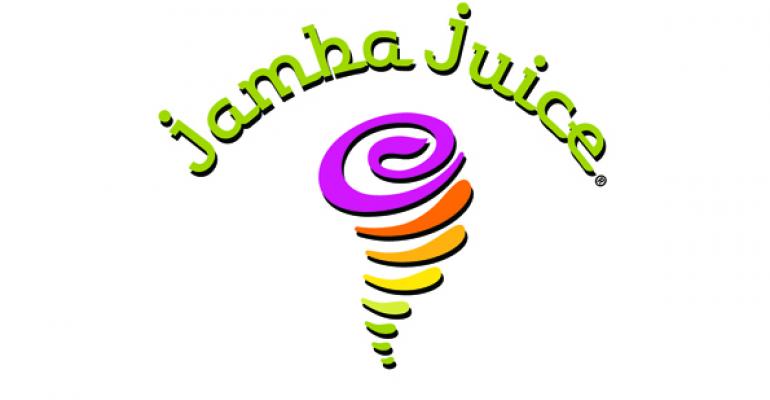When smoothies began appearing on menus at McDonald’s, Burger King and Starbucks, Jamba Juice began working to differentiate its brand.
Smoothies have gotten a bad reputation lately for being high in sugar and not always made with fruit.
James White, chief executive of Jamba Juice parent Jamba Inc., has been working on the 750-unit smoothie chain’s menu over the past two years to position the brand as a more healthful alternative.
RELATED
• Jamba 1Q same-store sales rise nearly 13%
• Jamba splits with Nestlé, targets consumer products
• More quick-service restaurant news
This summer, Jamba Juice launched a “Make It Light” option for its 10 classic smoothies, which cuts calories, sugar and carbohydrates by a third. The “Make It Light” version replaces the nonfat frozen yogurt or sherbet used in classic smoothies with a lower-calorie dairy base sweetened with Splenda.
A 16-oz. classic Banana Berry smoothie, for example, has 270 calories and 57 grams of sugar. The Make It Light version, however, has 170 calories and 32 grams of sugar.
The menu has also been diversified over the past couple of years to include options like All Fruit smoothies; Fruit & Veggie blends that include nutrient-rich vegetables like spinach, kale and beets; fruit-and-yogurt parfaits with no frozen yogurt or sherbet; functional smoothies with additions like probiotics or protein; and fresh-squeezed juices and juice blends.
In May, Jamba created a new Healthy Living Council of nutritionists and dietary experts to help the brand evolve with more healthful offerings, as well as educate consumers and work with schools on healthy living and anti-obesity efforts.
One of those nutrition experts is Elizabeth Ward, a registered dietitian and spokesperson for the American Dietetic Association who has written several books, including “MyPlate for Moms, How to Feed Yourself & Your Family Better.”
Ward spoke with Nation’s Restaurant News about the evolution of Jamba Juice’s smoothies.
Smoothies have been criticized by dietitians in recent years. How do you see that reputation changing?
There’s been a big evolution of smoothies, from something regarded as a treat to what Jamba is trying to do, to make it a drink that delivers good nutrition on many levels. The Healthy Living Council is helping the company make even more of a transition — they’ve already made huge strides — but to make it even better and to respond to what people want. Making something with fewer calories is great, but you also need to look at what else is in there, like higher protein content or the vitamins and minerals that are delivered in these drinks. The focus is on what can I get in that cup, and that’s where Jamba is going.
When you compare calorie and sugar content of McDonald’s smoothies with a classic version at Jamba Juice, they look very similar. How are they different?
Calories and sugar don’t tell the whole story, especially when you’re talking about whole fruit that’s blended and fruit juice. It’s really hard to distinguish where the sugar is coming from. I can’t tell you what’s in McDonald’s smoothies, but you’d have to drill down. Are they starting with whole fruit or a juice blend? When you use whole fruit and 100-percent pure fruit juice, you’re getting vitamins and minerals and fiber that you’re not getting from a smoothie base or blend that a lot of places start with.
The mayor of New York has proposed a ban on sugary drinks larger than 16 ounces. As proposed, fruit juices may be exempt, but by description, many larger-sized smoothies would not be allowed under the ban. What do you think of the proposal?
What Mayor Bloomberg was going for was trying to get people to stop drinking sugary drinks because of empty calories. People are downing these calories with no nutrients. A 16-ounce smoothie from Jamba Juice is head and shoulders above a 16-ounce lemonade or soda. If fruit juices are exempt, I would assume fruit smoothies would be exempt. The intention of the proposal is very important to consider. We want you to get away from drinks that are offering nothing for the calories. When you’re consuming 200 calories, you want to get vitamins and minerals and protein.
Jamba has fruit-and-vegetable smoothies, for example, and they make a great combination. It’s a way to work in your vegetables, especially with kids. Getting them to get their vegetables is a daily challenge. Jamba’s All Fruit smoothies are all under 250 calories at 16 ounces, and they offer multiple servings of fruit.
Jamba Juice is moving into schools, where many states restrict food offerings to those that meet certain nutrition standards. How has the chain dealt with that?
We have restrictions about what we can take on campus. There are size restrictions in elementary and middle schools, and we only use All Fruit or Fruit & Veggie smoothies. When you get into high school, sizes can get larger. Typically we’re part of a weekly menu, so a school might have them once in a week. Foodservice directors are designing menus with smoothies as an alternative to soda. It doesn’t replace things like milk, water or juice.
Can you share other ways you’d like to see Jamba Juice evolve as you work with the chain’s Healthy Living Council?
We’ve had discussions that have been really fruitful. I can’t tell you everything we’ve talked about, but I am incredibly impressed by how receptive everyone has been to our ideas. You will see even more innovation, and smoothies will continue to get better as they strive to serve their customers' needs. Everyone has their wish list, and we will see them come to fruition. It’s how we’re helping consumers. As the Healthy Living Council we have so many plans for helping people live better. It’s not just delivering the product but supporting the lifestyle. Keep your eye on Jamba Juice because you will see them lead even more.
Contact Lisa Jennings at [email protected].
Follow her on Twitter: @livetodineout





